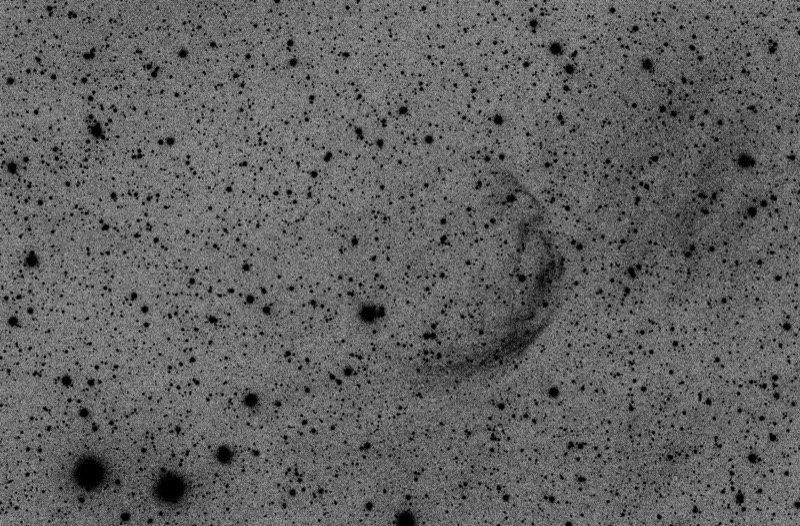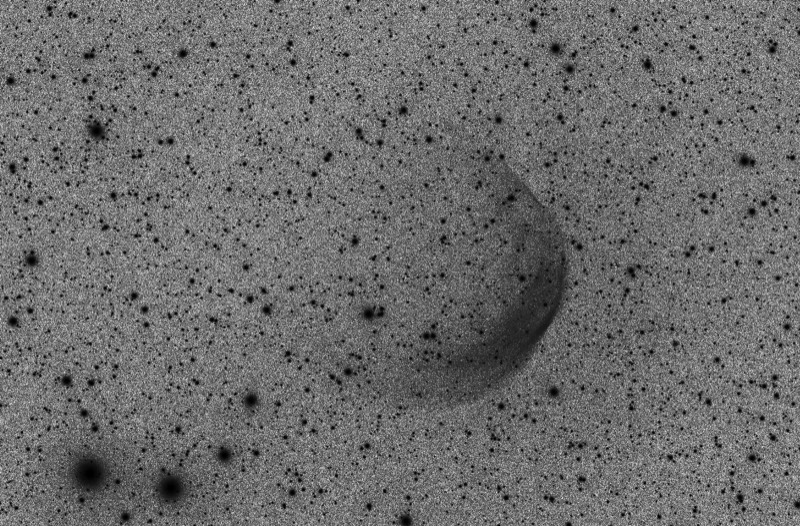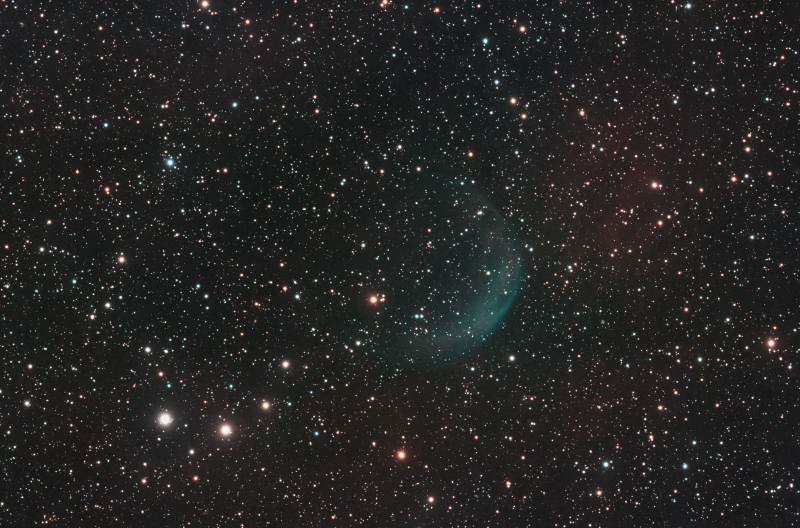Ancient Planetary Nebula FR 2-25, AlvKn1 in Monoceros
Published 2 May 2021
Click on image for un-cropped full resolution

Highly stretched inverted Ha image

Highly stretched inverted OIII image
About this object
FR 2-25, also known as AlvKn1 is an ancient and very faint planetary nebula discovered by Astronomer David Frew in 2008 and Amateur Astronomers Filipe Alves and Mattias Kronberger in 2012. It displays a prominent bow shock that is the result of it interacting with the interstellar medium (ISM). It is near 20 arc minutes in diameter and emits mostly in Ha and OIII light. Its distance is .87 Kpc or roughly 2838 light years. The position is RA: 08 04 28 DEC: -06 34 51. The blue central star is magnitude 16 and is offset from the center of mass of the HII and OIII emission (See annotated image). There are also many faint PGC galaxies in the field. I also included an annotated image showing where these galaxies are and a hash mark over the reported central star.
The above images are crops of a larger field of view. Clicking on the main color image will open a full resolution un-cropped version. I included 2 very strongly stretched and inverted HII and OIII images illustrating how faint this object is. There is also some faint HII emission up and to the right of the main object, seen as red in the color image and as a slightly darker area to the right of the bow shock in the HII image. The images were taken at 2x2 binning with a 152mm refractor resulting in a resolution of 1.28 arc sec/pixel.
The only other color image I know of, and could find on-line, was from the Chilean Advanced Robotic Telescope, http://www.chart32.de/component/k2/objects/planetaty-nebulae/fr-2-25-planetary-nebula
FR 2-25, also known as AlvKn1 is an ancient and very faint planetary nebula discovered by Astronomer David Frew in 2008 and Amateur Astronomers Filipe Alves and Mattias Kronberger in 2012. It displays a prominent bow shock that is the result of it interacting with the interstellar medium (ISM). It is near 20 arc minutes in diameter and emits mostly in Ha and OIII light. Its distance is .87 Kpc or roughly 2838 light years. The position is RA: 08 04 28 DEC: -06 34 51. The blue central star is magnitude 16 and is offset from the center of mass of the HII and OIII emission (See annotated image). There are also many faint PGC galaxies in the field. I also included an annotated image showing where these galaxies are and a hash mark over the reported central star.
The above images are crops of a larger field of view. Clicking on the main color image will open a full resolution un-cropped version. I included 2 very strongly stretched and inverted HII and OIII images illustrating how faint this object is. There is also some faint HII emission up and to the right of the main object, seen as red in the color image and as a slightly darker area to the right of the bow shock in the HII image. The images were taken at 2x2 binning with a 152mm refractor resulting in a resolution of 1.28 arc sec/pixel.
The only other color image I know of, and could find on-line, was from the Chilean Advanced Robotic Telescope, http://www.chart32.de/component/k2/objects/planetaty-nebulae/fr-2-25-planetary-nebula
Image Details
- Optics : Stellarvue SVX 152T refractor @f8 1200mm FL
- Mount: Paramount MYT
- Camera: ZWO ASI6200
- Filters: Chroma 50mm RGB, and 5nm OIII, Astrodon 50mm 5nm Ha
- Exposure (min): RGBHaOIII 30:45:45:660:700 24.6 hrs, 2x2 binning
- Automation Control: The Sky X, Voyager, PrimaluceLab Eagle 4
- Guiding: StarlightXpress Lodestar X2
- Processing Software: PixInsight, PS CC, Topaz Labs
- Location: Stark Bayou Observatory, Ocean Springs, MS
- Sky: Typical SQM 19.6, Bortle 5, Suburban
- Date: 23 Feb-11 April 2021







